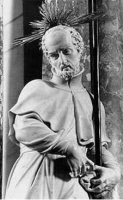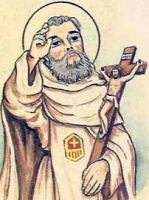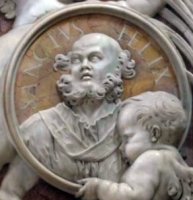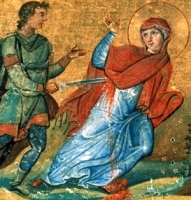Saint John Francis Regis
Also known as
• Jean-François Régis
• John-Francis Regis
• John Francis Regis
• Johannes Frans Régis
Additional Memorial
2 July (Jesuits)
Profile
Son of a wealthy merchant. Educated at the Jesuit college at Beziers, and at Cahors, Le Puy, Auch, and Tournon. Joined the Jesuits at age 18. Preacher. Catechist who was so good that children he taught helped bring their parents back to the Church. Ordained at age 34. Worked with plague victims in Toulouse, France. Taught at Pamiers.
His skill at preaching caused him to be sent as evangelist to provinces that had fallen to the Huguenots following the Edict of Nantes, places where many had abandoned the Church. Not known for a polished style or appearance, his simple method of preaching the Truth, and his willingness to work for the poor, converted crowds of farmers, workers, and country folk. When pressed about his image he replied, "The rich never lack confessors." He lived off apples, black bread, and whatever came to hand, preferring to spend his time preaching, teaching, and hearing confessions.
Established hostels for prostitutes, whom he called "Daughters of Refuge", who wished to leave the business. He was often assaulted for his trouble. Helped a group of country girls stay away from the cities by establishing them in the lacemaking and embroidery trade, an area of which he a patron saint.
Established the Confraternities of the Blessed Sacrament; to the society women he offered the "gift" of a few hungry mouths to feed, while to others he sent notes like,
"Sir, you will provide food for the poor people who names are listed below, and you will give them six sous for their lodging. If you are unable to provide them with food, you will give them a further six sous so that they may buy it themselves."
They did. Established a granary for the poor which sometimes miraculously refilled, demanded (and received) treatment for them by doctors, nurses, and pharmacists. Known for miraculous healing, but said that "every time God converts a hardened sinner, He is working a far greater miracle."
At one point there was a movement against him by some of his fellow Jesuits who felt his zealous "signs of simplicity and indiscretion" did not best showcase their order nor follow its teachings. Regis' bishop, however, recognized there was more jealousy than theology in the complaint, and ignored it. Regis asked for transfer to Canada where he could preach without worries about the politics of the Order, but he was ordered to continue his good works in the French countryside.
At age 43 Regis had a premonition of his death. He spent three days in retreat, made a general confession, and resumed his mission in mountain villages. Bad weather set in, he spent his days preaching, his nights in poor shelter, developed pleurisy and then pneumonia. His last words were "Jesus, my Savior, I recommend my soul to You."
Born
31 January 1597 at Font-Couverte, Narbonne, Languedoc, France
Died
31 December 1640 of pneumonia while preaching a mission at La Louvesc, Dauphine, France
Canonized
16 June 1737 by Pope Clement XII
Blessed Giuseppina Nicoli
Profile
Fifth of ten children born to a pious family. Joined the Daughters of Charity of Saint Vincent de Paul at the San Salvario house in Turin, Italy on 24 September 1883. In 1885 she was assigned to the island of Sardegna; she spent most of her life ministering to the poor there.
In June of 1899 she became the director of the Sassari orphanage, and spent her free time teaching catechism to the poor, the illiterate, and the daughters of rich people whose children went to fine schools with no religious education. She encouraged Eucharistic Adoration, supported the Associazione dei Figli di Maria (Association of the Sons of Mary), and was director of the Associazione delle Figlie di Maria (Association of the Daughters of Mary).
From 1910 to August 1914 she was recalled to Turin to serve as provincial administrator and then as director of the seminary, but her superiors finally understood the level of work she had done in Sardegna, and returned her there. Though the civil government had become decidedly anti-clerical, she continued her good work, and even opened a School of Religion for young people. Worked with sick infants and children at the Marina Colony of the Poetto for several years, and turned part of the building into a hospital for wounded soldiers during World War I.
During the whole of her time on the island she worked whenever possible with the Monelli di Maria (Urchins of Mary), children who were orphaned, homeless, abandoned, or thrown out of the house by their families. She got them to Mass, taught them catechism, to read and to write, and made sure they learned a trade so they could leave life on the streets. All this was done with the secret admiration of, but the open scorn of, most authorities who did not think such children could be reformed or saved.
Born
18 November 1863 in Casatisma, Pavia, Italy
Died
• 9am on 31 December 1924 in Cagliari, Italy of bronchial pneumonia
• her birth family wanted to bury her next to her parents in Casatisma, Italy, but the people of Cagliari begged that she not leave them, and the family agreed
• in October 1932 her body was moved to the chapel at the Asilo della Marina, Cagliari
Beatified
• 3 February 2008 by Pope Benedict XVI
• recognition celebrated at the Square of the Basilica of Our Lady of Bonaria, Cagliari, Italy, presided by Cardinal José Saraiva Martins
Saint Columba of Sens
Profile
Born to the Spanish nobility. At age 16 she and other Christians fled Spain for Gaul (modern France) to escape the persecutions of Emperor Aurelian. They were located, however, and imprisoned. Legend says that while Columba was in prison, one of the jailers tried to rape her; a bear that was being used at a nearby amphitheatre attacked the guard and rescued her. However, she and the rest of the group were later martyred in the on-going persecutions of Aurelian.
Tradition says that almost immediately upon her death a blind man named Aubertus asked for her intervention and had his sight restored. His first act was to run to her execution site and give her body a decent burial. A chapel was soon built at the grave, followed later by the Abbey of Sens. Other churches in France have borne her name, and in times past she had a strong devotion. This inevitably led to her association with pious fictions and legend.
Born
c.257 in Spain
Died
• beheaded in 273 at Sens, France near a fountain named d'Azon
• relics were enshrined in Sens
• relics destroyed by Huguenots in the 16th century
Blessed Alan de Solminihac
Also known as
Alain, Alamus, Alanus
Additional Memorial
3 January (Augustinians)
Profile
Born to a noble, pious and patriotic family, Alan wanted to join the Knights of Malta, to serve God while in the military. Instead, however, he became an Augustinian Regular at Chancelade Abbey, Périgueux, France at age twenty. Superior of the abbey in 1623. He worked to restore order and piety to his men, and was so successful that the reforms spread to other local houses.
Bishop of Cahors, France for 23 years from 1636 until his death. There he continued his reforms of the religious houses, and evangelization of his parishioners. Noted for his face-to-face meetings with the laity, Alan visited each of his 800 parishes at least nine times during his espicopate. He held a synod, episcopal council, founded a seminary, sponsored home missions and charities, brought back traditional devotions, and promoted adoration of the Eucharist. Attended the Council of Trent, and followed the lead of Saint Charles Borromeo in enforcing the Council's decrees in his home diocese.
Born
25 November 1593 in the family castle at Belet, Dordogne, France
Died
31 December 1659 at Mercues, Lot, France of natural causes
Beatified
4 October 1981 by Pope John Paul II
Saint Melania the Younger
புனிதர் இளைய மெலனியா
பாலைவனத்து அன்னை:
பிறப்பு: கி.பி 383
ரோம் (Rome)
இறப்பு: டிசம்பர் 31, 439
ஜெருசலேம் (Jerusalem)
ஏற்கும் சமயம்:
ரோமன் கத்தோலிக்க திருச்சபை
மரபுவழி திருச்சபை
கிழக்கு கத்தோலிக்க திருச்சபைகள்
நினைவுத் திருநாள்: டிசம்பர் 31
புனிதர் இளைய மெலனியா, ஒரு கிறிஸ்தவ புனிதரும், மற்றும் "பாலைவனத்து தாய்" (Desert Mother) என்று அழைக்கப்பட்டவரும் ஆவார். இவர் பேரரசர் "முதலாம் தியோடோசியஸின்" (Theodosius I) மகன், பேரரசர் "ஹொனொரியஸ்" (Emperor Honorius) ஆட்சி காலத்தில் வாழ்ந்தவர் ஆவார். இவர், "பாலைவனத்து தாய்" (Desert Mother) என்று அழைக்கப்பட்ட பெரிய மெலனியாவின் (Melania the Elder) மகன்வழி பேத்தி ஆவார்.
இவர், பண்டைய ரோம அதிகாரியான (Proconsul of Achaea) "வலேரியஸ் மேக்சிமஸ் பசிலியஸ்" (Valerius Maximus Basilius) மற்றும் "பெரிய மெலனியா" (Melania the Elder) ஆகியோரின் மகனான "வலேரியஸ் பப்லிகோலா" (Valerius Publicola) மற்றும் அவரது மனைவியான "அல்பினா" (Albina) ஆகியோருக்குப் பிறந்தவர் ஆவார். இவர், தமது தந்தை வழி உறவினரான "வலேரியஸ் பினியானஸ்" (Valerius Pinianus) என்பவரை, தமது பதினான்கு வயதில் திருமணம் செய்துகொண்டார்.
இவர்களிருவரும், தமக்குப் பிறந்த இரண்டு குழந்தைகளின் ஆரம்பகால மரணங்களுக்குப் பிறகு கிறிஸ்தவ துறவறத்தைத் தழுவி, பின்னர் பிரம்மச்சரியமான வாழ்க்கையை வாழ்ந்தனர். தனது பெற்றோரின் செல்வத்தை வாரிசாகப் பெற்றபின், அதை அநாமதேய இடைத்தரகர்கள் மூலம் திருச்சபை நிறுவனங்களுக்கும் ஏழைகளுக்கும் நன்கொடையாக வழங்கினார்.
கி.பி. 410ம் ஆண்டு, அவர்கள் ஆப்பிரிக்காவுக்கு பயணம் செய்தனர். அங்கே, பண்டைய கிறிஸ்தவ இறையியளாராகிய (Early Christian Theologian) புனிதர் "ஹிப்போவின் அகுஸ்தினார்" (St. Augustine of Hippo) அவர்களுடன் நட்பு கொண்டனர். அவருடன் இணைந்து, பக்தி மற்றும் தொண்டு பணிகளின் வாழ்க்கையில் தங்களை அர்ப்பணித்துக் கொண்டனர்.
அங்கே, அவர்கள் இருவரும் சேர்ந்து ஒரு கான்வென்ட்டை நிறுவினார்கள். மெலனியா, அதன் அன்னை சுப்பீரியர் ஆனார். அதன் நிர்வாகப் பொறுப்புகளை அவருடைய கணவர் "பினியானஸ்" ஏற்றார். கி.பி. 417ம் ஆண்டு, அவர்கள் அலெக்ஸாண்ட்ரியா (Alexandria) வழியாக பாலஸ்தீனத்திற்கு (Palestine) பயணம் செய்தனர். அங்கே, ஆலிவ் மலைக்கு (Mount of Olives) அருகிலுள்ள ஒரு துறவு மடத்தில் (Hermitage) வசித்தனர். அங்கேயும் மெலனியா ஒரு கான்வென்ட்டை நிறுவினார்.
கி.பி. 420ம் ஆண்டு, பினியானஸ் இறந்த பிறகு, மெலனியா ஆண்களுக்காக ஒரு துறவு மதத்தையும், ஒரு தேவாலயத்தையும் கட்டினார். அங்கு அவர் தனது வாழ்நாளின் எஞ்சிய பகுதியைக் கழித்தார்.
மெலனியா, சிசிலி (Sicily) நாட்டிலும், பிரிட்டனிலும் (Britain) பரந்த நிலங்களை சொத்துக்களாகக் கொண்டிருந்தார். "ஐபீரியா" (Iberia), "ஆப்பிரிக்கா" (Africa), "நுமிடியா" (Numidia), "மௌரெட்டானியா" (Mauretania ) மற்றும் இத்தாலி (Italy) ஆகிய நாடுகளிலும் பெரும் தோட்டங்களை வைத்திருந்தார்.
ஜெரொன்டியஸ் (Gerontius), அவரது தோட்டங்களில் ஒன்றை பின்வருமாறு விவரிக்கிறார்:
ஒருபுறம் கடலும், மறுபுறம் பலவிதமான விலங்குகள் மற்றும் விளையாட்டுகளைக் கொண்ட சில வனப்பகுதிகள் உள்ளன. அதனால் அவர் குளத்தில் குளிக்கும்போது கப்பல்கள் கடந்து செல்வதையும், காடுகளில் விளையாட்டு விலங்குகளையும் காண முடிந்தது. இந்த சொத்துக்கள் ஒவ்வொன்றிலும், அறுபது பெரிய வீடுகள் இருந்தன. அவற்றில் ஒவ்வொன்றிலும் நானூறு விவசாய அடிமைகள் இருந்தனர். இவ்வாறு, இந்த ஒரு சொத்தில் 24,000 அடிமைகள் இருந்தனர்.
கி.பி. 452ம் ஆண்டு, "ஜெரொன்டியஸ்" (Gerontius) என்பவர், மெலனியாவைப் பற்றி எழுதிய ஒரு வாழ்க்கை வரலாற்றில், அவரது துறவு வாழ்க்கையைப் பற்றி எழுதியிருந்தார். மேலும், அவரது வாழ்க்கையைப் பற்றி "பல்லடியஸ்" () என்பவர், கி.பி. 431ம் ஆண்டு, சுயசரிதம் எழுதியிருந்தார்.
Profile
Wealthy Roman patrician noble; granddaughter of Saint Melania the Elder. Married against her will to Valerius Pinianus (Saint Pinian) at age 13. After the death of their two children, both of whom died young, and to escape Visigoth invasion, the couple fled to Tagaste in North Africa in 410 where they had estates, and where they met Saint Augustine of Hippo. Though they stayed married, the two took vows of celibacy, freed their slaves, sold their lands and goods in Spain and Gaul, and gave the proceeds to the poor. They built two monasteries for Saint Augustine, then the couple moved to Jerusalem and entered a monastery and convent around 417. Friend of Saint Paulinus of Nola and Saint Jerome. Widowed in 432. Directed the convent on the Mount of Olives for several years.
Born
c.383
Died
late December 439 at Jerusalem of natural causes
Pope Saint Sylvester I
புனிதர் முதலாம் சில்வெஸ்டர்
33ம் திருத்தந்தை:
பிறப்பு: ----
சாந்தாஞ்சலோ ஆ ஸ்காலா, அவெல்லீனோ
இறப்பு: டிசம்பர் 31, 335
ரோம், இத்தாலி
நினைவுத் திருவிழா: டிசம்பர் 31
திருத்தந்தை முதலாம் சில்வெஸ்டர் (Pope Sylvester I) ரோம் ஆயராகவும் திருத்தந்தையாகவும் கி.பி. 314ம் ஆண்டு, ஜனவரி மாதம், 31ம் நாளிலிருந்து கி.பி. 335ம் ஆண்டு, டிசம்பர் மாதம், 31ம் நாள் வரை திருப்பணி செய்தார். இவருக்கு முன் ஆட்சியிலிருந்தவர் திருத்தந்தை “மில்டியாட்ஸ்” (Pope Miltiades) ஆவார். திருத்தந்தை முதலாம் சில்வெஸ்டர் கத்தோலிக்க திருச்சபையின் 33ம் திருத்தந்தை ஆவார்.
இத்திருத்தந்தையின் திருப்பணிக் காலத்தில் ரோம் நகரில் பேரரசன் காண்ஸ்டண்டைன் (Constantine) வலிமை மிக்கவராக விளங்கினார். அவர்களின் ஆட்சியின்போது ரோம் நகரில் தலைசிறந்த பேராலயங்கள் பல கட்டப்பட்டன. அவற்றுள் சிறப்பாக, புனித பேதுரு பேராலயம், “தூய இலாத்தரன் யோவான் முதன்மைப் பேராலயம்” (Basilica of St. John Lateran), “எருசலேம் திருச்சிலுவை பேராலயம்” (Santa Croce in Gerusalemme), “பழைய தூய பேதுரு பேராலயம்” (Old St. Peter's Basilica) ஆகியவையும், பிற பல மறைச்சாட்சியரின் கல்லறைகள் மீது கட்டப்பட்ட ஆலயங்களும் உள்ளடங்கும்.
திருப்பணிக்காலத்தில் நடந்த முக்கிய நிகழ்வுகள்:
முதலாம் சில்வெஸ்தரின் திருப்பணியின் போது, கி.பி. 325ம் ஆண்டு, “நிசேயா பொதுச் சங்கம்” (First Council of Nicaea) நிகழ்ந்தது. அச்சங்கத்தைக் கூட்டியது சில்வெஸ்டர் அல்ல, மாறாக காண்ஸ்டண்டைன் (Constantine) மன்னன் ஆவார் என்பது குறிப்பிடத்தக்கது. அச்சங்கத்தில் சில்வெஸ்டர் நேரடியாகப் பங்கேற்கவில்லை. ஆனால் அவருடைய பதில் ஆட்களாக “வீத்துஸ்” (Vitus), “வின்சென்சியுஸ்” (Vincentius) என்னும் இரு மூப்பர்-குருக்கள் (Legates) கலந்துகொண்டனர். சங்கத்துக்குத் தலைமை தாங்கியவர் கோர்தோபா ஆயர் ஓசியுஸ் என்பவர். சங்கம் நிறைவேற்றிய தீர்மானங்களை சில்வெஸ்தர் ஏற்று, ஒப்புதல் வழங்கினார்.
திருத்தந்தையின் வாழ்க்கை பற்றிய புனைவு நிகழ்ச்சிகள்:
சில்வெஸ்தரின் வாழ்க்கையில் நடந்ததாக சில நிகழ்வுகள் பிற்காலத்தில் (கி.பி. 5ம் நூற்றாண்டு) புனையப்பட்டன. காண்ஸ்டண்டைன் மன்னன் தொழுநோயால் அவதிப்பட்டதாகவும், சில்வெஸ்தர் அவருக்குத் திருமுழுக்கு அளித்ததும் மன்னரின் நோய் நீங்கியதாகவும் புனைவுகள் உருவாகின. கொடிய நோயிலிருந்து விடுதலை பெற்ற மன்னர் சில்வெஸ்தருக்குத் தலைவணங்கினார். சில்வெஸ்தர் ஒரு மணிமுடியை எடுத்து காண்ஸ்டண்டைன் மன்னனின் தலையில் சூடினார்.
பிற்காலத்தில் எழுந்த இப்புனைவு வலியுறுத்திய கருத்து இது:
மன்னருக்கு அதிகாரம் வழங்கியவர் திருத்தந்தையே. எனவே திருத்தந்தைக்கு ஆன்மிக அதிகாரமும் உலக ஆட்சி அதிகாரமும் உண்டு. இக்கருத்தின் அடிப்படையில் பிற்காலத்தில் திருத்தந்தையர் ஆன்மிகத் தலைவர்களாக மட்டுமன்றி, அரசியல் ஆட்சியாளர்களாகவும் தங்கள் பதவியை நியாயப்படுத்தினர். மேலும் ஆட்சியாளர்களை நியமிக்கவும் பதவி நீக்கம் செய்யவும் தமக்கு அதிகாரம் உண்டு என்றும் உரிமைகொண்டாடினர்.
மற்றொரு புனைவுப்படி, சில்வெஸ்டர் ஒரு பறவை நாகத்தைக் கொன்று, அந்த விலங்கின் தாக்குதலுக்குப் பலியாகி இறந்தவர்களுக்கு அற்புதமாக மீண்டும் உயிர் கொடுத்தார். சில்வெஸ்டரைச் சித்தரிக்கும் ஓவியங்களில் பறவை நாகம் இடம்பெறுவது இப்புனைவின் அடிப்படையில்தான்.
இறப்பும் அடக்கமும்:
சில்வெஸ்தரின் பணிக்காலம் ஏறக்குறைய 22 ஆண்டுகள் நீடித்தது. அவர் கி.பி. 335ம் ஆண்டு, டிசம்பர் மாதம், 31ம் நாள் இறந்தார். அவரது உடல் ரோம் நகரை அடுத்த சலாரியா சாலையில் அமைந்த புனித பிரிசில்லா கல்லறைத் தோட்டத்தில் அடக்கம் செய்யப்பட்டது. அவரது உடலில் மீபகுதிகளை 762ம் ஆண்டில் திருத்தந்தை “முதலாம் பவுல்” ரோம் நகருக்கு உள்ளே அமைந்த சில்வெஸ்டர் ஆலயத்தில் மீள் அடக்கம் செய்தார்.
நினைவுத் திருவிழா:
கத்தோலிக்க திருச்சபை சில்வெஸ்டரின் நினைவுத் திருவிழாவை டிசம்பர் மாதம், 31ம் நாள் கொண்டாடுகிறது. கிழக்கத்திய மரபுவழி திருச்சபைகளும் கிழக்கு மரபுவழி கத்தோலிக்க சபைகளும் ஜனவரி மாதம், 2ம் நாள் சிறப்பிக்கின்றன.
Also known as
Silvester
Profile
Son of Rufinus. Pope in the reign of Emperor Constantine I. Built the Basilica of Saint John Lateran and other churches. Sent legates to the First Council of Nicaea, and was involved in the controversy over Arianism. The spurious Donation of Constantine was supposedly given to Saint Sylvester.
Born
Roman
Papal Ascension
314
Died
• 31 December 335 at Rome, Italy
• relics transferred to the Church of Saint Sylvester in Capite in Rome in 761
Saint Marius Aventicus
Also known as
Marius Aventicensis
Profile
Born to a rich, distinguished family with roots in the Roman empire. Ordained as a young man. Bishop of Avenches, Switzerland in 574; he later moved his see to Lausanne. Participated in the Council of Mâcon in 585. A skilled goldsmith, he made altar vessels by hand. Noted as scholar, a man of prayer, and a protector of the poor. A chronicle of his time has survived; it purports to be a continuation of the Chronicon Imperiale of Prosper Tiro, covers from 455 to 581, and is a key source for Burgundian and Franconian history.
Born
c.530 in the diocese of Autun, Burgundy (in modern France)
Died
• 31 December 594 at Lausanne, Switzerland of natural causes
• buried in the church of St-Thyrse in Lausanne
Canonized
1605 (cultus confirmation)
Saint Zoticus of Constantinople
Also known as
• Feeder of Orphans
• Zotico
Profile
Wealthy noble Roman citizen. He first surrendered his position to become a priest, and then gave away his worldly wealth to the poor and lived to work for his parishioners. When Emperor Constantine the Great transferred the capital of his empire from Rome to Constantinople, Zoticus went along. There he built a hospital for the poor and orphans. He preached the orthodox faith against the heretical Arian Emperor Constantius, for which preaching he was martyred.
Born
Italy
Died
dragged through the streets of Constantinople behind a wild ass c.350
Blessed Walembert of Cambrai
Also known as
Garembert
Profile
Studied with the canons of Sainte-Walpurga, Veurne, Flanders, Belgium. Servant to Mayor Oylard in Saint-Quentin, Cambrai, France. Hermit in Bony, Cambrai. Augustinian monk. Built an abbey in the diocese of Cambrai, France in 1119; he served as its first abbot while his sister served as abbess. In 1136 the house moved to Mont-Saint-Martin and became associated with the Premonstratensians.
Born
1084 near Furness, Belgium
Died
31 December 1141 of natural causes
Blessed Leandro Gómez Gil
Profile
Trappist monk. Martyred in the Spanish Civil War.
Born
13 March 1915 in Hontomín, Burgos, Spain
Died
31 December 1936 in Santander, Cantabria, Spain
Beatified
• 3 October 2015 by Pope Francis
• beatification recognition celebrated at the cathedral of Santander, Spain, Cardinal Angelo Amato principal celebrant
Holy Family
Memorial
Sunday after Christmas
Profile
Jesus, Mary and Joseph in their relationship as a human family.
Saint Hermes the Exorcist
Also known as
Hermes of Rome
Profile
Priest. Exorcist. Martyred in the persecution of Marcus Aurelian.
Died
c.270
Saint Festus of Valencia
Also known as
Sextus, Sextius
Profile
Fifth-century bishop of Valencia, Spain. When his city was invaded by barbarians, their leader Chrocus demanded that the people renounce Christianity; they refused, and Chrocus turned his men loose on them. Festus and many of his flock died as martyrs.
Saint Barbatian of Ravenna
Profile
Fifth century priest at Antioch (in modern Turkey). While in Rome, Italy on a mission he was befriended by Empress Placidia Augusta who built a monastery for him at nearby Ravenna, Italy. He worked there are superior, and as a counselor to the throne.
Saint Sabinian of Sens
Also known as
Sabinianus, Savinien
Profile
First bishop of Sens, France. Martyr. Some legends list him as a disciple of Saint Peter, but because of the dates, this is clearly impossible.
Died
c.300
Blessed Wisinto of Kremsmünster
Profile
Benedictine monk. Priest. Served at the abbey of Kremsmünster, Austria. Austrian Benedictines have always considered him Saint Wisinto but elsewhere he known as Blessed.
Died
c.1250 of natural causes
Saint Theophylact of Ohrid
Profile
Clerk of the Hagia Sophia church in Constantinople. Reluctant bishop of Ohrid, Macedonia, serving for 25 years. Noted theologian and orator; many of his homilies and commentaries have survived to today.
Died
1126
Blessed Peter of Subiaco
Profile
Benedictine monk. Abbot of the monastery of Subiaco, Italy. Blinded and imprisoned by the baron of Monticello for defending the rights of his abbey. He died in prison, and is considered a martyr.
Died
1003
Saint Potentian of Sens
Profile
Second bishop of Sens, France. Martyr. Some legends list him as a disciple of Saint Peter, but because of the dates, this is clearly impossible.
Died
c.300
Saint Pinian
Also known as
• Pinianus
• Valerius Pinianus
Profile
Married to Saint Melania the Younger. Father of two; both children died very young. About 410 the couple left Rome, Italy, and each entered religious life. Monk.
Died
c.438
Blessed Dominic de Cubells
Profile
Mercedarian preacher and evanglists working from the convent of Santa Maria in El Puig, Spain.
Saint Gelasius of Palestine
Profile
Fifth-century monk in Palestine. Opposing the Monophysite heresy, he was expelled from his monastery.
Saint Offa of Benevento
Profile
Benedictine nun and abbess at Saint Peter's convent, Benevento, Italy.
Died
c.1070 of natural causes
Martyrs of Catania
Profile
A group of early Christians martyred together, date unknown. The only other information to survive are ten of their names - Attalus, Cornelius, Fabian, Flos, Minervinus, Pontian, Quintian, Sextus, Simplician and Stephen.
Died
Catania, Sicily, Italy
Martyrs of Rome
Profile
A group of Roman women martyred in an early persecution, date unknown. We known the names of ten of them - Dominanda, Donata, Hilaria, Nominanda, Paolina, Paulina, Rogata, Rustica, Saturnina and Serotina.
Died
relics enshrined in the catacombs of Via Salaria, Rome, Italy
St. Donatus of Rome
Martyred: c. 363 AD during the reign of Roman Emperor Julian the Apostate
Venerated as a saint by:
Catholic Church
Eastern Orthodox Church
Feast day: December 31st
Memorial: Basilica Santi Cosma e Damiano, Rome, Italy
Unfortunately, there is not a lot of information readily available about St. Donatus’ life or martyrdom. What we do know is that he was a Christian who lived in Rome during the 4th century, a time of great persecution for Christians under Emperor Julian.
According to tradition, St. Donatus was put to death for his faith on December 31st, 363 AD. He is said to have been beheaded along with 72 other Christians. Their remains were buried in a cemetery near the Porta Portese, a gate in the Aurelian Walls of Rome.
In the 6th century, a basilica was built over the cemetery, known as the Basilica Santi Cosma e Damiano. The basilica was later dedicated to Sts. Cosmas and Damian, but St. Donatus is still commemorated there, and his feast day is celebrated on December 31st.
Zeno of Rome
Zeno the Isaurian, who also held the title of Eastern Roman Emperor and ruled from 474 to 491 AD. While December 31st isn't his universally recognized feast day, some local traditions and Orthodox calendars do commemorate him on that date.




















